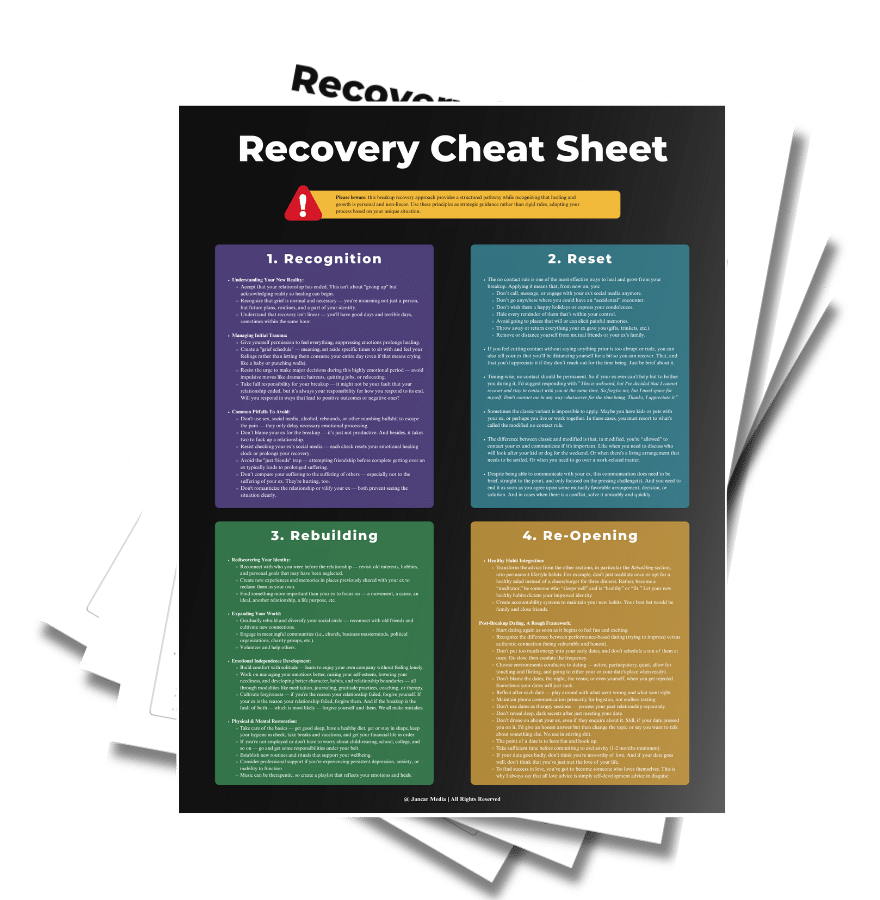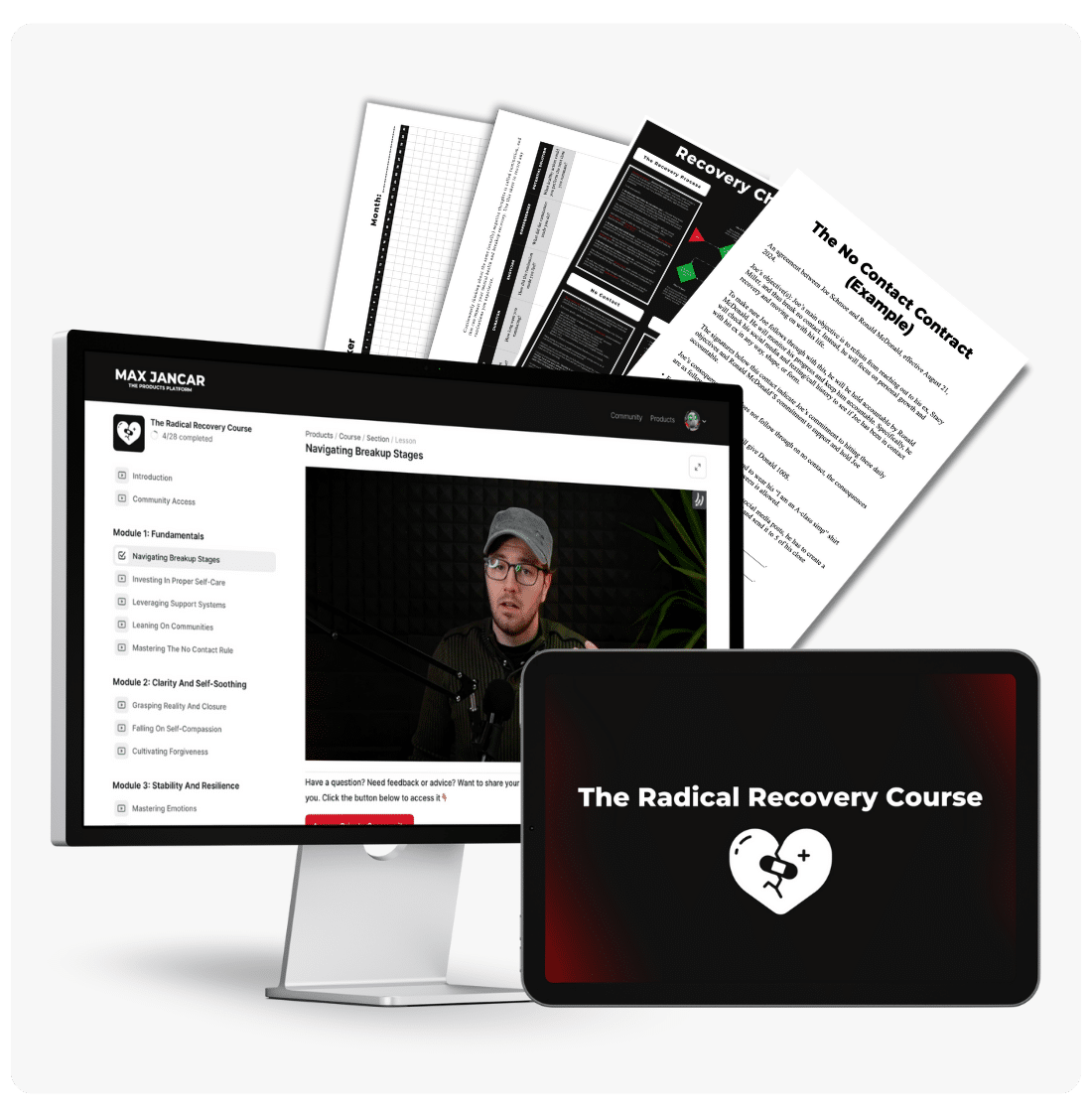Click play to listen to this article.
In the aftermath of a breakup, your emotional landscape becomes a minefield. One moment, you’re fine; the next, you’re spiraling because you scrolled past an old photo, heard “your song,” or got that dreaded late-night text from your ex. Suddenly your heart races, your stomach tightens, and that familiar heaviness returns to your chest.
While we can’t control our ex’s actions or erase our shared history, psychological research suggests we have significant power in how we respond to these triggers. And the space between a triggering event and our reaction is where our true freedom exists, where healing becomes possible.
A guide to breakup recovery based on embracing discomfort, extracting wisdom from dark moments, and healing through evidence-based practices.
Order Your CopyStep 1: Name What You’re Really Feeling
When breakup triggers strike, our emotions often blend together into an overwhelming mess. So the first step is identifying exactly which emotion has taken hold of you.
Your body provides important clues about your emotional state. Research shows that what we call “emotions” are essentially physical patterns — changes in breathing, blood flow, muscle tension, and gut sensations. By developing awareness of these bodily signals, you can begin to regain control.
Consider which of these common post-breakup emotions best describes your current state:
- Anxiety: restlessness, worry, fear about the future.
- Anger: resentment, bitterness, rage toward your ex.
- Grief: profound sadness, emptiness, longing.
- Shame: feeling exposed, rejected, or not good enough.
- Jealousy: envy, possessiveness, fear of replacement.
Simply labeling your emotion creates distance between you and the feeling. As in, you’re not “being angry” — you’re “experiencing anger,” which means you can also experience something else.
This cheat sheet lays out 40+ solutions to overcoming a breakup so you can create a new opportunity for love — be that with your ex or someone completely different.
Get The Free Cheat SheetStep 2: Decode Your Trigger’s Buried Message
Triggers aren’t random — they reveal unmet needs that deserve your attention. When you see your ex with someone new and feel devastated, what’s really happening beneath the surface?
Well, research on emotional triggers identifies several core needs that, when unfulfilled, create powerful emotional responses. After a breakup, these unfulfilled needs often include:
- Feeling valued and worthy.
- Security and certainty.
- Emotional connection.
- Validation and recognition.
- Autonomy and independence.
- Fairness and respect.
- Belonging and acceptance.
Try identifying the three primary needs not being met when you get triggered. This creates what I’d call your personal trigger equation.
For example:
When your ex doesn’t respond to your message:
Trigger = Lack of acknowledgment + respect + closure
When you see them enjoying life on social media:
Trigger = Lack of inclusion + fear of replaceability + comparison
Understanding these equations helps you address the actual needs rather than getting caught in surface-level reactions.
Step 3: Recalibrate Your Emotional System
Once you’ve identified your emotion and decoded your trigger, you can actively shift your state through nervous system regulation. How exactly is this done? Well, try any of these evidence-based approaches:
- Movement meditation. Find a private space and walk slowly, focusing entirely on the physical sensations of each step (learn more about meditation here).
- Rhythmic breathing. Inhale for a count of four, hold for two, then exhale for six.
- Physical release. Tension from emotional triggers gets stored in your body. Try progressive muscle relaxation — tensing and releasing each muscle group from your feet to your head — to discharge stored emotional energy.
- Mindful acceptance. Sometimes, you simply need to feel your feelings fully. So create a safe, comfortable space, set a timer for 10 minutes, and allow yourself to experience the emotion without judgment or resistance.
- Cold exposure. Splash cold water on your face or take a cold shower.
- Perspective journaling. Write about what you’re grateful for despite the breakup and what future opportunities might emerge from this painful transition (learn more about journaling here).
- Vocalization. Humming, singing, or making extended “om” sounds creates vibrations that stimulate the vagus nerve, reducing anxiety and shifting you out of trigger-induced panic. Try this for 2-3 minutes when overwhelmed.
- Social regulation. Call a supportive friend who won’t judge your emotions or reinforce negative patterns. Simply sharing space with someone safe can help recalibrate your emotional state.
- Nature immersion. Take a break to connect with nature — feel the grass, listen to birds, or simply watch clouds pass overhead.
- Sensory grounding. For example, use the 5-4-3-2-1 technique: identify 5 things you can see, 4 things you can touch, 3 things you can hear, 2 things you can smell, and 1 thing you can taste.
- Creative expression. Channel trigger emotions into art, music, dance, or writing without censoring yourself.
- Compassionate self-talk. Develop a phrase to repeat when triggered, such as “This feeling is temporary” or “I’m growing through this pain.” (learn more about self-compassion here).
- Intentional distraction. Sometimes strategic, temporary distraction prevents rumination spirals. So engage in an activity requiring full concentration — a puzzle, complex recipe, or intense workout — to interrupt the trigger-response pattern.
The key with all the above methods is experimentation — different triggers may respond to different techniques. So try as many as you can, and over time, you’ll likely develop a personalized emotional toolkit for managing breakup aftermath.
But above all, remember that while you can’t control your ex or erase your shared past, you absolutely can manage how these experiences affect you. The more you practice responding rather than reacting to triggers, the faster your heart will recover.
This cheat sheet lays out 40+ solutions to overcoming a breakup so you can create a new opportunity for love — be that with your ex or someone completely different.
Get The Free Cheat SheetRelated Reading
- How To Love Yourself After A Breakup (7 Realistic Activities) November 20, 2021
- A Complete Guide On How To Be Happy After A Breakup February 16, 2024
- 3 Surprising Reasons You Can’t Get Over Your Ex August 22, 2024
- 6 Myths About Emotions (And What To Believe Instead) March 4, 2022
- I Dream About My Ex Every Night (Why And How To Stop) November 20, 2021
- How To Get Over Your Ex And Move On For Good February 10, 2023



